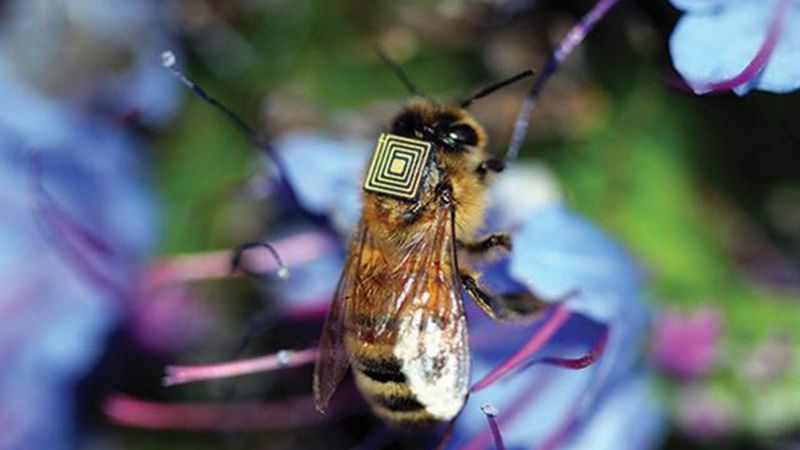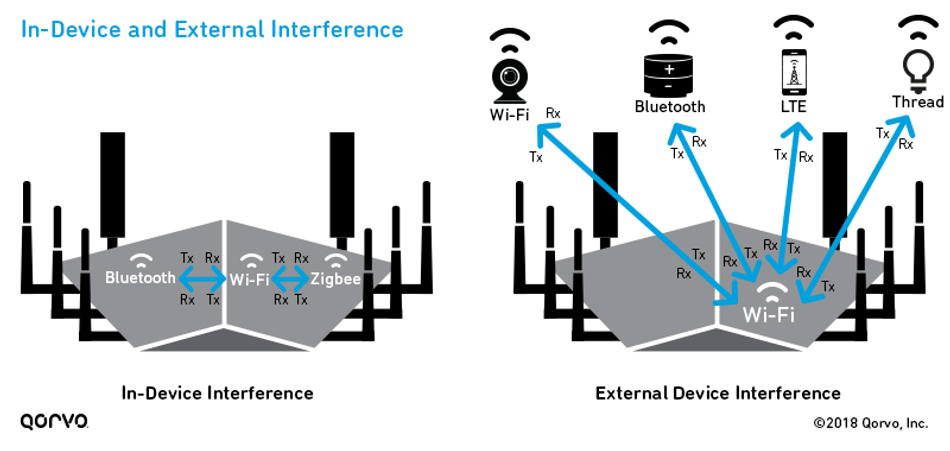BAW filters for Performance Improvements in Wi-Fi, 5G, and RF Applications
Article #6 of Next-Gen Wi-Fi Applications and Solutions Series: Bulk Acoustic Wave (BAW) filters are high-performance chips that help in mitigating interference and reducing the physical size of 5G, Wi-Fi, and other RF communication system designs.

Image credit: CSIRO
This is the sixth and the final article in a 6-part series featuring articles on Next-Gen Wi-Fi Applications and Solutions. The series focuses on the improvements Wi-Fi 6/6E and its applications bring to enhance the performance of the next-gen wireless networking devices. This series is sponsored by Mouser Electronics. Through the sponsorship, Mouser Electronics shares its passion for technologies that enable smarter and connected applications.
As discussed in the previous articles of our Next-Gen Wi-Fi Applications and Solutions Series, improving wireless communication performance is no longer limited to just pushing the limits of raw data transfer rates. To offer an improved user experience, it is necessary to mitigate interference and optimize the use of the available frequency spectrum in the best possible way.
The sixth and the final article of the ongoing series examines the interference problem in-depth and explains how Bulk Acoustic Wave (BAW) technology offers a promising solution to maximize spectrum utilization by high-precision filtering to recover signals with greater noise immunity.
Solving the Interference Problem
Cellular networks, Wi-Fi, ZigBee®, Bluetooth®, and several other protocols all share a common Radio Frequency (RF) space. They use different modulation schemes, channel widths, channel spacings, and frequency-hopping algorithms.
As next-generation services and devices emerge, more frequencies, bandwidth, coexistence, and interference immunity is needed. This means claiming more of the spectrum that was lost using older technologies.

Spectrum utilization is the key, and as the move from 3G to 4G increased the number of bands from 5 to 40, recovering clean signals from a world of muddying interference is getting tougher.
In other words, for reaching deep into a turbulent pool of RF, more precision filtering is needed to recover stronger and more reliable signals with improved noise immunity. And with handheld devices that feature multiprotocol transceivers that can operate simultaneously, the need for 40 filters is not uncommon. Even within a home setting, Wi-Fi routers suffer, and end-point devices fall victim here as well.
Improving Performance Through Precision Filtering
Key to improving performance are filters, but older space-eating Surface Acoustic Wave (SAW) filter technologies are reaching a brick wall as far as being effective solutions to the doubling of RF bands is concerned.
Supplanting SAW filters is BAW technology. Both are forms of electromechanical resonators. The structure of the BAW resonator consists of a thin layer of a piezoelectric material sandwiched between two electrodes. When an electric field is applied across the electrodes, the piezoelectric crystal excites an acoustic wave. As the wave propagates through the surface, cavities are formed between the electrodes. [1]
This technology can handle higher power levels than SAW devices. Electric current distributes more freely, and there are no narrow channels of fingers prone to electromigration damage as in SAW filters. Bulk filters have been used to partition the bands and are proving a more reliable bandwidth within the band. BAW technology extends the edges of the filters while maintaining sharp band edges.
BAW filters, which can be made using crystal quartz, can be 1000 times smaller than ceramic technologies while retaining low cost at high-volume manufacturing. As this technology takes over older SAW solutions, new and tightly packed filters can allow smaller, more clever use of specific bands and power levels to set up a true next-generation band-sharing technique.
To sum it all up, here is a list of key advantages BAW filters offer:
Sharp band edges: Systems using BAW filters showcase a high rejection in the frequencies outside of the band edges. This helps in reducing the leakage of signal outside the used frequencies.
Smaller size: Whole BAW filter can be fabricated on a single IC as opposed to some crystal oscillators that require a dedicated footprint and a triggering Resistor-Capacitor (RC) circuit. This feature helps in the size reduction of the PCB used in the end product.
Temperature stability: Though the products are designed to work at 25 °C, in practical applications, the temperatures can go up to 60-80 °C due to high ambient temperatures and heat emitted by other components. BAW filters are more resilient to these extremities as compared to SAW filters.
All the observations point to a single direction, and that is towards a system with less interference than ever before.
New Ways of Partitioning and Preferential Allocation of Bands
WiFi 6E’s expansion in the 6 GHz band grants more number of non-overlapping channels for connected devices to communicate over. The jump from 5 GHz to 6 GHz band is a pretty significant upgrade than it may appear at first.
2.4 GHz | 5 GHz | 6 GHz | |
20 MHz | 3 channels | 25 channels | 60 channels |
40 MHz | 1 channel | 12 channels | 29 channels |
80 MHz | N.A. | 6 channels | 14 channels |
160 MHz | N.A. | 2 channels | 7 channels |
Table 1: Number of non-overlapping channels in Wi-Fi
With just a GHz increase in the frequency, the latest WiFi standard increases the number of non-overlapping channels by more double compared to the 5 GHz band. One of the reasons for such a large increase in the number of channels is the unavailability of bands reserved for RADARs in the sub-5 GHz frequencies, which is not a concern in the 5-6 GHz frequencies.
To make use of all the available channels to the fullest and transition between interfering bands, engineers can make use of BAW filters in their designs. These filters help to avoid interference from band to band and are large enablers of capacity increase. For customers, this translates to reduced interference and an increase in the effective range of the devices. Multiple users can communicate at the same time with the router.
With improved filters exhibiting higher power levels, taking up less space, device-specific and even protocol-specific partitioning of the airwaves can take place. Additionally, design engineers can classify power levels based on criticality, throughput, or other importance so that channel assignments for noncritical transmissions avoid these channels.
For example, a high-speed streaming multimedia link has higher bandwidth needs than SMS texting services. An interruption in the streaming could be a turnoff if insufficient bandwidth or buffering is used. On the other hand, seconds of delay in SMS services would not even be noticed.
By the same token, newly emerging medical devices connected to the Internet of Things could use specific subsets of the newly evolved bandwidth to assure the most reliability while monitoring a patient or transferring error-free vitals. Even assigned fallback channels can be used to increase reliability.
High-performance BAW filters for cutting edge RF applications by Qorvo
As RF technology achieves new heights with each passing generation of Wi-Fi, cellular, and several other wireless communication networks, a precise filter is required to support wideband and high-frequency designs. Qorvo’s innovations in BAW technology are vital components in advanced filtering solutions for mobile products, radars, and other wireless communication technologies.
Qorvo BAW filters range from 1.5 GHz to 9 GHz, encompassing the consumer wireless bands as well as carrier services. Parts such as the QPQ1909SR perform signal-conditioning filtration within the 2402MHz to 2494 MHz bands for Wi-Fi bandage (Figure 1). Terminating into 50 Ω, the low 0.8 dB to 1.2 dB insertion loss is essential for maintaining signal integrity. 
BAW designs use the high-performance high-power edge boost Wi-Fi technology for channels 1 through 14. This means end-users will see a better quality of service as well as higher regulatory power allowances (to +30 dBm averaged input power). Note how the higher performance channels in conjunction with a priority scheme can ensure more reliable data communications to more critical applications.

BAW filters are not limited to better Wi-Fi solutions but are also useful for GPS, DiPlexer, Duplexers, and other assorted protocol-specific access points, routers, gateways, and wearables. If you are going to filter, it is a better idea to do it in bulk.
Conclusion
With the introduction of next-generation services and devices, more frequencies, bandwidth, coexistence, and interference immunity are required. As a result, design engineers must maximize spectrum utilization. BAW technology and filters enable the partitioning of frequency bands for more precision filtering to capture stronger and more reliable signals with enhanced noise immunity.
To read more about BAW filters and other technologies enabling better Wi-Fi solutions, do check out: Future-Proofing Wi-Fi by Mouser and Qorvo.
This article was initially published by Mouser and Qorvo in an e-magazine. It has been substantially edited by the Wevolver team and Electrical Engineer Ravi Y Rao. It's the sixth and the final article from the Next-Gen Wi-Fi Applications and Solutions Series.
- The introductory article provided an overview of wireless communication and the subsequent articles of the series.
- The first article explored the origins and the evolution of WiFi to showcase how the wireless local area networking standard improved over time.
- The second article was focused on recent trends and the design philosophy behind WiFi 6/6E. The article explains why even with a marginal improvement in raw data rates, WiFi 6/6E is the biggest upgrade yet.
- The third article dives into the technicalities of WiFi 6/6E. It explains the 6 enabling technologies of WiFi 6/6E including OFDMA, BSS Coloring, TWT, Beamforming, 8X8 MU-MIMO, and 1024-QAM.
- The fourth article is a comparison between WiFi and 5G based on some of the key performance parameters. It tries to form a perspective regarding which technology is suitable for different use cases.
- The fifth article features a discussion on where the wireless communication industry is headed to. Concepts like mesh WiFi networks are explored with excerpts from an interview with Cees Links, General Manager of the Low Power Wireless Business Unit in Qorvo and one of the leading pioneers of WiFi.
- The final article introduces the readers to the concept, benefits, and applications of BAW filters in WiFi, 5G, and other RF communication systems designs.
About the sponsor: Mouser Electronics
Mouser Electronics is a worldwide leading authorized distributor of semiconductors and electronic components for over 1,100 manufacturer brands. They specialize in the rapid introduction of new products and technologies for design engineers and buyers. Their extensive product offering includes semiconductors, interconnects, passives, and electromechanical components.
References
[1] Advanced BAW Filter Technology and Its Impact on 5G, Qorvo, [Online], Available from: https://www.qorvo.com/resources/d/qorvo-advanced-baw-filter-technology-impact-on-5g-white-paper
About Mouser Electronics
Mouser Electronics is a worldwide leading authorized distributor of semiconductors and electronic components for over 1200 industry-leading manufacturers. We specialize in the rapid introduction of...
202 Posts


